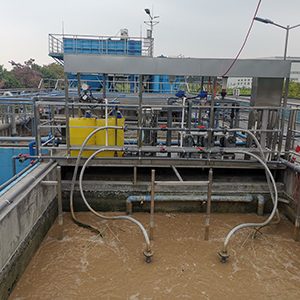MBR (Membrane Bioreactor) technology is a wastewater treatment process that combines the biological treatment process with a membrane filtration system. This technology has been increasingly used in recent years for its efficiency, cost-effectiveness, and superior quality treated water. In this blog, we will provide a comprehensive overview of MBR technology.
How Does MBR Technology Work?
MBR technology involves the use of a membrane filtration system to separate solids from wastewater. The membrane filtration system can be made of different materials such as polymeric, ceramic, or metallic membranes. The wastewater is first treated biologically in a tank using bacteria and other microorganisms to break down the organic matter.
The effluent from this tank is then fed to the membrane filtration system, where the membrane acts as a barrier and separates solids from the liquid. The treated water is then disinfected and ready for reuse or discharge.
Advantages of MBR Technology
- High-quality treated water: MBR technology produces high-quality treated water that meets or exceeds stringent water quality standards. The membrane filtration system can remove even the smallest particles and impurities, resulting in crystal clear, odorless water that is safe for reuse or discharge.
- Smaller footprint: MBR technology requires a smaller footprint compared to conventional wastewater treatment systems. This is because MBR systems eliminate the need for a separate clarifier, resulting in a compact design that can be installed in areas with limited space.
- Enhanced nutrient removal: MBR technology is effective at removing nutrients such as nitrogen and phosphorus from wastewater. This makes MBR technology ideal for wastewater treatment applications in areas with strict nutrient discharge limits.
- Reduced sludge production: MBR technology produces less sludge compared to conventional wastewater treatment systems. This is because MBR systems use the membrane filtration process to retain solids, resulting in a concentrated sludge that requires less treatment and disposal.
Disadvantages of MBR Technology
- High capital cost: MBR technology requires a higher initial investment compared to conventional wastewater treatment systems.
- Membrane fouling: Membrane fouling is a common challenge in MBR technology that can reduce the efficiency of the system. However, regular maintenance and cleaning can mitigate this issue.
Applications of MBR Technology
MBR technology is widely used in various applications such as municipal wastewater treatment, industrial wastewater treatment, and water reuse applications. MBR technology is ideal for treating wastewater with high organic loading, nutrients, and other contaminants.
In conclusion, MBR technology is a reliable and efficient wastewater treatment process that offers several advantages such as high-quality treated water, a smaller footprint, enhanced nutrient removal, and reduced sludge production. Hinada provides reliable and cost-effective MBR systems that can meet your wastewater treatment needs. Contact https://www.hinada.com/ today.
Contact Us
Hinada
Address: Building G1-302, Luogang District Kefeng Road No.31, Guangzhou City, Guangdong province -China.
Email: [email protected]
Phone No: +8613922297496
Business Hours: Mon – Sat: 9AM – 6PM
Website: https://www.hinada.com/
Follow Us on Regular Updates: Linkedin, Youtube, Whatsapp
Keywords Tag: ultrafiltration systems water treatment, wastewater treatment equipment, edi electrodeionization, ultra filtration system, electrodeionization system, pvdf ultrafiltration membrane, UF System, hollow fiber uf membrane, uf membranes, ultrafiltration membrane, ultrafiltration unit, uf ultrafiltration, ultrafiltration membrane manufacturers, mbr reactor, mbr technology, mbr membrane bioreactor, mbr membrane manufacturers, membrane bioreactor for wastewater treatment, mbr wastewater, mbr membrane, mbr wastewater treatment, Water Treatment Equipment Suppliers.


